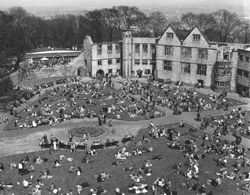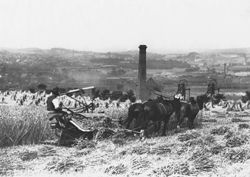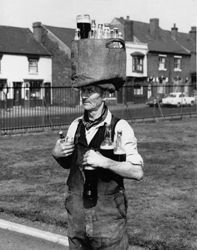You may be asking or wondering
WHAT ... or WHERE ... IS
"THE BLACK COUNTRY" ?
Not a country
Not a name on the map
Not an area of local government
 The
'Black Country' is defined by geology; it respects no human or administrative boundaries. Beneath the 'Black Country' lies the 30 foot (9.15 metre)
coal seam. This is Britain's thickest and richest seam of coal which, together with its adjacent seams of thin coal, iron, limestone and clay,
supported the development of the industrial region. The coal lies beneath Wednesbury, Darlaston, Wednesfield, Bilston, Coseley, Tipton, Dudley,
Brierley Hill and Halesowen, together with their nearby smaller townships, and at greater depth beneath West Bromwich, Oldbury and Smethwick.
A recently reprinted 1836 map of the extent of the seam includes much of Wolverhampton and also parts of Walsall. More modern thinking should include
most, if not all, of the four modern boroughs that cover the Black Country region, i.e. Dudley, Sandwell, Walsall and Wolverhampton.
The
'Black Country' is defined by geology; it respects no human or administrative boundaries. Beneath the 'Black Country' lies the 30 foot (9.15 metre)
coal seam. This is Britain's thickest and richest seam of coal which, together with its adjacent seams of thin coal, iron, limestone and clay,
supported the development of the industrial region. The coal lies beneath Wednesbury, Darlaston, Wednesfield, Bilston, Coseley, Tipton, Dudley,
Brierley Hill and Halesowen, together with their nearby smaller townships, and at greater depth beneath West Bromwich, Oldbury and Smethwick.
A recently reprinted 1836 map of the extent of the seam includes much of Wolverhampton and also parts of Walsall. More modern thinking should include
most, if not all, of the four modern boroughs that cover the Black Country region, i.e. Dudley, Sandwell, Walsall and Wolverhampton.
There has been much debate on the 'formal' or even 'informal' boundaries of the region. It is thought that there will never be a definition of the Black Country that will satisfy all people interested in the Black Country.
THE BLACK COUNTRY SOCIETY
believes the original Black Country to be:
 That
area of South Staffordshire and North Worcestershire (excluding Birmingham)
which was on the famous 30 foot seam of coal. By 1860, within 5 miles
of Dudley there were 441 pits, 181 blast furnaces, 118 iron works, 79
rolling mills and 1500 puddling furnaces, all pouring out smoke. This
led to the region being described as 'black by day and red by night'.
From the early 1700s scores of industrial townships and villages grew
in the area and from the late 19th century many local councils were created.
All these townships within the Black Country were consolidated into the
four Metropolitan
That
area of South Staffordshire and North Worcestershire (excluding Birmingham)
which was on the famous 30 foot seam of coal. By 1860, within 5 miles
of Dudley there were 441 pits, 181 blast furnaces, 118 iron works, 79
rolling mills and 1500 puddling furnaces, all pouring out smoke. This
led to the region being described as 'black by day and red by night'.
From the early 1700s scores of industrial townships and villages grew
in the area and from the late 19th century many local councils were created.
All these townships within the Black Country were consolidated into the
four Metropolitan  Boroughs
of Dudley, Sandwell, Walsall and Wolverhampton by the local government
re-organisations of 1966 and 1974, with a total population now in excess
of one million. With modern-day high technology replacing heavy industry
'the Green' not 'the Black' Country is arguably now more descriptive of
the region, but The Black Country Society has strenuously resisted suggestions
to change the name of the area believing that the heritage and history
of the Black Country is one to be proud of and cherished, and undoubtedly
worthy of preservation for future generations.
Boroughs
of Dudley, Sandwell, Walsall and Wolverhampton by the local government
re-organisations of 1966 and 1974, with a total population now in excess
of one million. With modern-day high technology replacing heavy industry
'the Green' not 'the Black' Country is arguably now more descriptive of
the region, but The Black Country Society has strenuously resisted suggestions
to change the name of the area believing that the heritage and history
of the Black Country is one to be proud of and cherished, and undoubtedly
worthy of preservation for future generations.
HISTORY OF THE SOCIETY
 The
Black Country Society, was founded in 1967 by enthusiasts led by the late
Dr John Fletcher, who felt that the Black Country did not receive its
fair share of recognition for its great contribution to the industrial
development of Britain and the world. The Society grew out of the Dudley
Canal Tunnel Preservation Society, which successfully campaigned to save
Dudley Canal Tunnel, threatened with closure by British Waterways and
British Rail. The Tunnel is now a major attraction at the Black
Country Living Museum. The Society's stated aim was 'to foster interest
in the past, present and future of the Black Country', and its voice,
at a specially called meeting on 6 October 1968, was one of the earliest
calling for the establishment of a local industrial museum. Since the
establishment of the Black Country Living Museum, the Society and individual
members have continually supported it. The Society has gone from strength
to strength, establishing an enviable reputation in publishing books and
magazines concerned with the Black Country, together with an active and
varied programme of events throughout the year.
The
Black Country Society, was founded in 1967 by enthusiasts led by the late
Dr John Fletcher, who felt that the Black Country did not receive its
fair share of recognition for its great contribution to the industrial
development of Britain and the world. The Society grew out of the Dudley
Canal Tunnel Preservation Society, which successfully campaigned to save
Dudley Canal Tunnel, threatened with closure by British Waterways and
British Rail. The Tunnel is now a major attraction at the Black
Country Living Museum. The Society's stated aim was 'to foster interest
in the past, present and future of the Black Country', and its voice,
at a specially called meeting on 6 October 1968, was one of the earliest
calling for the establishment of a local industrial museum. Since the
establishment of the Black Country Living Museum, the Society and individual
members have continually supported it. The Society has gone from strength
to strength, establishing an enviable reputation in publishing books and
magazines concerned with the Black Country, together with an active and
varied programme of events throughout the year.
WHY NOT BECOME A MEMBER?
For information on joining the Society, please click here.
For more detail, read our constitution.